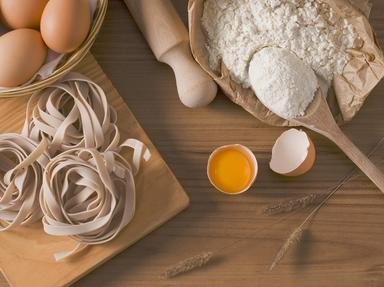Quiz Answer Key and Fun Facts
1. Almond flour is a gluten-free alternative, but is sometimes confused with almond meal. What is the difference between almond flour and almond meal?
2. Arrowroot flour is a gluten-free flour often used in biscuits. From which region of the world does arrowroot originate?
3. Farinata, or socca, is a type of pancake made from flour that is made from a specific legume. If I tell you that this legume is also used in hummus, can you guess what it is?
4. Cassava and tapioca can both be used to make gluten-free flours. What is the main difference between cassava and tapioca flours?
5. Various flours can be made from different types of rice. Which of these is not a real rice species?
6. Tiger nut flour is a rarer type of gluten-free flour with a nutty taste. Are tiger nuts actually nuts?
7. The meat of the coconut can be consumed in desiccated form, but can it be used to make flour?
8. Which gluten-free flour ingredient, originally from Africa, is also known as broomcorn, durra, imphee or milo?
9. Buckwheat flour can be used as a substitute for white or wheat flour, but is buckwheat actually a type of wheat?
10. Teff is an ancient grass native to the Horn of Africa. It is a staple of Ethiopian and Eritrean cuisine. Which flatbread from Ethiopia and Eritrea is traditionally made with teff flour?
Source: Author
Kankurette
This quiz was reviewed by FunTrivia editor
jmorrow before going online.
Any errors found in FunTrivia content are routinely corrected through our feedback system.
